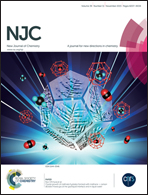DFT study of dihydrogen addition to molybdenum π-heteroaromatic complexes: a prerequisite step for the catalytic hydrodenitrogenation process†
Abstract
The range of molybdenum hydride complexes that are sought to participate in the important catalytic hydrodenitrogenation process (HDN) of nitrogen containing polycyclic aromatic hydrocarbons were evaluated by DFT studies. The previously synthesized stable (η6-quinoline)Mo(PMe3)3 complex 1N, in which molybdenum is bonded to the heterocyclic ring, was chosen as a model. The hydrogenation of the quinone heterocycle, which was postulated as the initial step in the overall HDN reaction, is found to occur via three consecutive steps of the oxidative addition of dihydrogen to Mo in 1N. Successive transfer of hydrogen atoms from the metal to the heterocycle leads to the ultimate formation of the tetrahydrido molybdenum intermediate Mo(PMe3)4H413 and 2,2,3,3-tetrahydroquinoline C9H11N 14. All the involved intermediates and transition states have been fully characterized by DFT. This computational modeling of the hydrogenation of quinoline, as a part of extended HDN catalytic processes, provides a fundamental understanding of such mechanisms.


 Please wait while we load your content...
Please wait while we load your content...